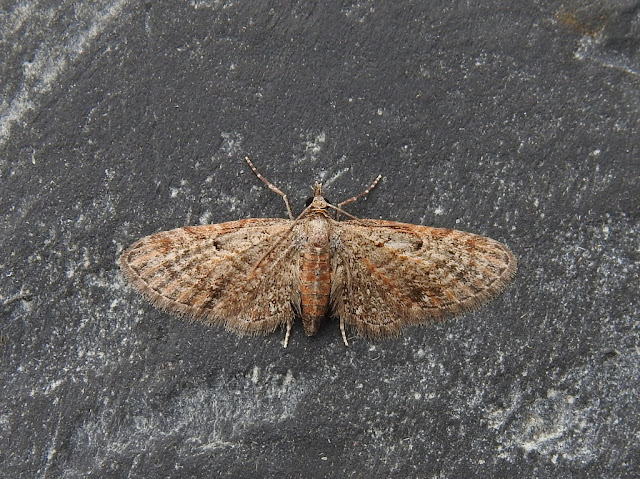At this stage of my mothing career there are two principal factors which influence my pleasure in a particular moth. One is its aesthetic value; the other, its rarity. I know how superficial that sounds, and hopefully other factors will come to play a more prominent role in my appreciation of moths. Things like a species' fascinating life cycle, or interesting behaviour, say; or the knowledge that here is a moth which has suffered catastrophic decline in recent years. This is certainly true of birding, and it's been a long time since looks and rarity were the be-all and end-all.
In the meantime: aesthetic value. On this basis alone, there are several moths on my most-wanted list. Very often they are species which have featured regularly on my Twitter feed (but not in my trap) and thereby stirred a strong desire to make their acquaintance. Usually they are relatively common, like Lime and Pine Hawk-moth, Leopard Moth, etc. Which brings me to Tuesday night...
Tuesday evening was warm and overcast. I had high hopes. Not long after dark, I glanced outside and spied a chunky beast clinging to the moth towel...

|
|
Oh wow! Lime Hawk Moth was everything I hoped it would be. Just
awesome! |
That was about 22:30, and already there were several moths buzzing around the trap. I fetched the net. It was going to be a long night...
Two lovely moths from my most-wanted list was just the start. What about rarity then? The thing with rarity is that I frequently have no idea a moth is rare until I research it. One micro trapped on Tuesday night illustrates this nicely. I was pretty sure it was a Gelechiid, but there are loads of intricately patterned ones like this one, and in my crack-of-dawn, bleary-eyed state I had no desire to pick carefully through the plates in 'Manley', so resorted to ObsIdentify. Which gave me Carpatolechia fugitivella, at a very high level of confidence. And yes, it matched perfectly...

|
|
There is some Elm in our neighbour's garden hedge, which may or may not
be significant. |
As per normal, I checked the Dorset Living Record map to get some idea of the county status of this 6 or 7mm scrap of a moth. Well...

|
|
Each dot represents one record. So, not common then! |
Some eye candy, some rarity buzz, and what else? 215 moths of 74 species constitutes one of my best catches so far, and there were several other highlights...

|
|
A tiny little gem, and a garden first. Not uncommon though. |

|
|
First Slender Pug of the year. Six records in 2022 has given us
the biggest Bridport dot on the species' Living Record map. Not sure
what the attraction is. It's a Willow feeder. |

|
|
New for the year. Just a single in 2022. |

|
|
First of the year. Quite common, with 13 garden records in 2022. |

|
|
Single-dotted Wave. First 2023 record of this common, diminutive
moth. |

|
|
At the opposite end of the spectrum to the previous moth, what a delight
to find this monstrous Privet Hawk-moth in the trap. Our second
this year. |

|
|
A garden-first Broad-barred White. Seemingly common enough
Dorset-wide, but for some reason there are no Living Record dots in the
Bridport area. |
Such a nice haul of moths - including 14 new for year and five new for garden - was a lot of fun, but hard work to ID and record. I was away for Wednesday and Thursday nights, so tonight will be the final trap of the month. With the half-year garden tally currently standing at 313, will any be added before June is out I wonder?
In other news...
Devon's first recorded breeding Avocets hatched three chicks this week, at Black Hole Marsh in Seaton. All credit to East Devon District Council, and its former employee Fraser Rush in particular, for the creation and development of this superb wetland habitat. Tempting Avocet to breed in Devon was one of the project's specific goals, and may have seemed overly optimistic back in the mid-noughties. Yet here we are. It was only right that Wednesday's lunch break should be extended to include a visit. I would like to say I captured some fine shots of the happy family, but cannot. Instead, have this...

|
|
| One of the parents. |
Also, the following screenshot of Tim White's tweeted pic. I did manage some
photos which included all three chicks, but they are pointless in the face of
this masterful shot of two of them. If you haven't come across Tim's bird
photography, or his incredible astronomical images, he is well worth a follow
on Twitter:
@ColytonWildlife.

























































